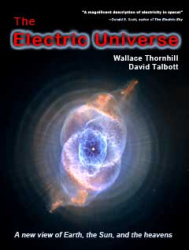|
|
Excerpts From The Electric Universe
Part 4
The following is one of a series of excerpts from The Electric Universe,
copyright © 2002, 2007 Wallace Thornhill and David Talbott and published by
Mikamar Publishing. Reproduced with the kind permission of the authors and publisher.
Presented by Dave Smith
|
|
|
|
February 11, 2010
|
|
|
Through this series of Special Edition Thunderblogs it is emerging
that the electric theory of comets offers a far superior explanation of observations
than does the standard model. Having previously explored the main features of
comets it is now pertinent to take a closer look at their many enigmatic surface
features such as spires, pits and craters.
Page 99
Unexplained Surface Features
|
|
|
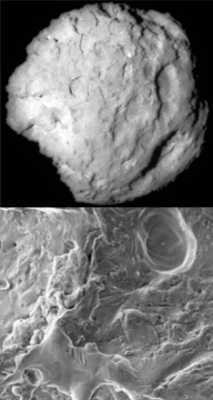
Top: Comet Wild 2 in close-up.
Credit: NASA/JPL-Caltech.
ABOVE: A microscopic view of an
EDM surface.
Flat floored
depressions with steep scalloped
walls and terracing are evident.
Image credit: B. Mainwaring
[Click to enlarge]
|
|
|
When the roughly 5 kilometers-wide Comet Wild 2 was first seen
in dramatic close-up, Donald Brownlee, Stardust Principal Investigator,
said, “We thought Comet Wild 2 would be like a dirty, black, fluffy
snowball. Instead, it was mind-boggling to see the diverse landscape
in the first pictures from Stardust, including spires, pits and craters,”
101
features that are more likely for a solid rock than a melting,
icy pile of rubble (see image [above]
and on p. 101). Among the surface
anomalies are two depressions with flat floors and nearly vertical walls
that resemble giant footprints. They aren't structured like typical impact
craters.
Regardless, a number of scientists declared that the craters were
the result of impacts—the catch-all explanation for craters in the
space age. But in the vast emptiness of the outer solar system, impacts
are exceedingly unlikely, and with the low relative velocities there, it
is inconceivable that a small body would have attracted end-to-end
cratering.
Today, most astronomers distance themselves from the impact
explanation of the Wild 2 surface. But that leaves the mystery of crater
formation unsolved. Some astronomers suggested that the craters
are sinkholes, formed when surface material fell into cavities left by
the sublimation of buried volatiles. But the smooth, flat floors of the
craters belie such an explanation. Nor is it reasonable to suggest that
heat from the Sun would reach down through many meters of insulating
material to remove subsurface volatiles in volumes sufficient to
provoke surface collapse. And even if that were a plausible sequence,
the miniscule gravity of comet nuclei is hardly sufficient to justify a
comparison of their craters to terrestrial 'sinkholes.'
Page 100
A minority of astronomers came to suggest that some of the comet
dilemmas could be resolved if comet nuclei were 'rubble piles.' But
no comet, when seen close up, revealed surface features suggesting a
heap of fragments. After the Deep Impact mission, NASA investigators
publicly stated that the rubble pile hypothesis had turned out to
be a “non-starter.”
|
|
|
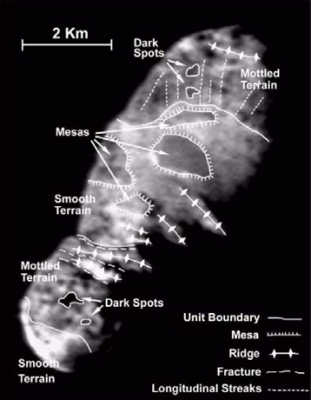
Comet Borrelly's nucleus, as recorded by
Deep Space 1 on September 22, 2001.
Details as small as 50 meters can be
resolved on the 8-kilometer-long object.
Image Courtesy NASA/JPL.
[Click to enlarge]
|
|
|
The images of comet nuclei from passing spacecraft support a
complex history. The surface features of Comet Borrelly
[above] were
described as “Earth-like.”
Dr. Dan Britt, a meteoriticist in the
University of Tennessee's Planetary Geosciences Institute, noted that
the mesas on Borrelly resembled those in the American Southwest.
In a characteristic understatement, NASA scientists described the
findings as “somewhat surprising.”
It is no overstatement to say that none of the defining features of
comet nuclei has met the expectations of the Whipple model. In
contrast their features are consistent with—and predictable—under the
electric comet model.
|
|
|

Dr. Earl Milton (1935-1999) was an
associate professor of physics at the
University of Lethbridge, Alberta,
Canada. He was a close colleague of
Ralph Juergens. He published several
papers on the electric model of
comets and other aspects of the electric
universe.
Photo: W. Thornhill, 1983.
[Click to enlarge]
|
|
|
Another pioneer of the electric universe, Earl Milton
[above],
noted in 1980 that he and Juergens had independently concluded that a
comet nucleus would be scarred “like an electrode in an arc. Over
time the cometary nucleus should become cratered and pitted…When a
spacecraft finally achieves a rendezvous with one of the comets,
scientists are going to be surprised to find a surface pitted like that of
the Moon, Mars, or Mercury.”
102
At the time, scientists had never seen
a comet surface. The first flyby of a comet took place 6 years later.
|
|
|
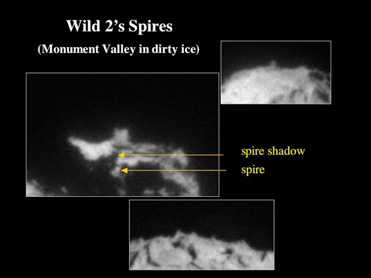
Numerous strange pinnacles as long
as 100 meters long jutting off the
surface. The pinnacles were unexpected.
Other unusual Wild 2 surface
features include long cliffs,
deep pits and craters.
Credit: Stardust Team, JPL, NASA
[Click to enlarge]
|
|
|
Other surface enigmas stand out as well. Images of Comet Wild 2
have revealed unexplained bright spots (below).
|
|
|
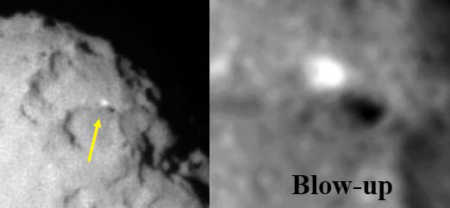
[Click to enlarge]
|
|
|
In the electrical
model of comets, these are the 'touchdown' points of the cathode
arcs—where electric currents between the comet and the Sun 'pinch
down' on the more negatively charged nucleus of the comet. The result
is analogous to electric discharge machining (EDM), etching the surface
into the observed “spires, pits and craters.” They appear to be
Page 101
etched sharply into rock, offering nothing to support the
idea of sublimating ice or snow (see above). The caption on
the Astronomy Picture of the day lamely offers, “these features
are hypothesized to be indicative of a very rigid surface
sculpted by impacts and explosive sublimation. Initially,
Wild 2 was expected by many to be held together
only quite loosely.”
103
Generating Comet Jets
|
|
|
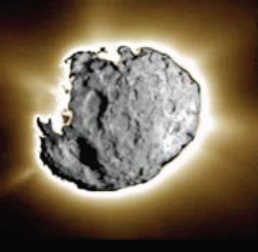
Comet Wild 2. This composite
image uses a time exposure to
reveal the jets.
Credit: Stardust Team, JPL, NASA
[Click to enlarge]
|
|
|
NASA's Stardust spacecraft captured images of Comet
Wild 2 on January 2, 2004. and issued a composite of the
nucleus and a longer exposure highlighting the comet's jets
(facing page). According to a Stardust project press release,
mission scientists expected “a dirty, black, fluffy snowball”
with a couple of jets that would be “dispersed into a halo.”
Instead they found more than two dozen jets that
“remained intact—they did not disperse in the fashion of a gas in a
vacuum.” The jets “...remained strong and coherent even hundreds of
miles from the comet's surface. Stardust's very bumpy ride during its
passage through the coma was an unmistakable sign of the power and
strength of the jets.”
104
Some of the jets emanated from the dark unheated side of the
comet—an anomaly no one had expected. Chunks of the comet, including
rocky particles as big as bullets, blasted the spacecraft as it
crossed three jets. A principal investigator also spoke of energetic
bursts “like a thunderbolt.”
105
The extreme fineness, high speed and narrow trajectories of dust
particles from comets has been a puzzle ever since the first flyby of
Comet Halley by the Giotto spacecraft. But from an electric viewpoint
these comet enigmas are easily explained: an arc impinging on a
cathode or anode surface vaporizes and sputters matter from that
surface; the electric field of the arc accelerates matter off the surface;
an electromagnetic 'pinch effect' provides densities in the thin jets
many orders of magnitude higher than those predicted from simple
radial sublimation; and instabilities in the arc cause flickering and
sudden relocation of jets in exceedingly short periods.
The jets are not due to solar heating but are generated by wellfocused
electric arcs wandering across the nucleus to progressively
etch its surface, carving out the surface craters and flat floored valleys,
Page 102
and leaving spires and mesas, in the well-known process of cathode
erosion.
Comets are, in fact, doing exactly what the electric model would
predict. Given that out-gassing from an icy nucleus should vary in
proportion to available surface area, it is suspicious that now five
comets, adjusted to the same heliocentric distance, should have such
similar rates of 'loss of water' (based on the presence of OH in the
coma). But if material is being machined electrically from very small
arc footprints, the surface area of the comet and solar heating are
irrelevant to the volume of removed material.
Forming Comet Comas
The International Cometary Explorer (ICE) was the first
spacecraft ever to pass through a comet's coma boundary, which is
misnamed a 'bow shock.' Before the encounter with Comet Giacobini-
Zinner, astrophysicists were not sure whether a bow shock would be
encountered at all: The boundary was called simply the 'transition
region.'
Without realizing it, the ICE mission confirmed the signature of
electric current filaments in the plasma sheath. Electrical currents flow
in the comet's plasma sheath and cause atoms there to glow. The
currents announced themselves by the magnetic turbulence present.
This was not the official interpretation, of course, but the
observations conformed to Alfvén's earlier electric circuit model of
comets. He had written, “As Venus, like the comets, has no appreciable
intrinsic magnetic field, the solar wind interaction with her is likely to
be essentially the same.”
106
A report in Science confirmed Alfvén's
prediction: “a similar field pattern [to the comet] has been observed at
Venus.”
107
Significantly, the magnetic field at the comet peaked at six
times that found at Venus, revealing the degree to which a comet
transacts electrically with the solar plasma.
Deep Space 1 provided further evidence of electrical effects as it
flew through the plasmasphere surrounding the nucleus of comet
Borrelly. Mission specialists had expected that the solar wind would
flow symmetrically around the coma, with the nucleus in the centre.
They found that the solar wind was indeed flowing symmetrically, but
the nucleus was off to one side, shooting out a great jet of material.
“The shock wave is in the wrong place,” said Dr. Marc Rayman. Dr.
David Young of the University of Michigan added, “The formation of
the coma is not the simple process we once thought it was. Most of the
charged particles are formed to one side, which is not what we
Page 103
expected at all.” One commentator said that it was like finding the
shock wave from a supersonic jet a mile to the side of the aircraft!
However, the analogy is false. The luminous crescent in the
image [below] is not due
to the nucleus mechanically plowing
through the plasma ahead of it. In a cometary plasma sheath, the
most energetic recombination will take place under the direction of
the electric force some distance from the comet nucleus in the direction
of the Sun.
|
|
|
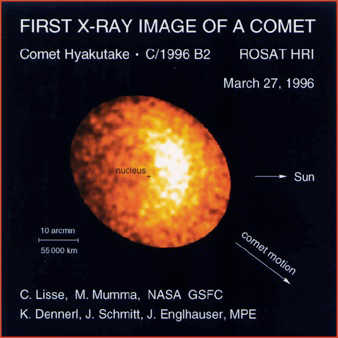
Credit: C. Lisse, M. Mumma (NASA/GSFC),
K. Dennerl, J. Schmidt, and J. Englhauser (MPE)
[Click to enlarge]
|
|
|
Direct confirmation of the electric nature of the coma came
unexpectedly from the ROSAT satellite when it observed Comet
Hyakutake in March 1996 [above]. “We had no clear
expectation that comets shine in X-rays,” said Dr. Michael Mumma
of NASA's Goddard Space Flight Center. The X-rays were as
intense as those the satellite usually sees from bright X-ray stars. And
the X-ray variability over a few hours was “remarkable.” The
observation provoked scientists to say, “This important discovery
shows that there must be previously unsuspected 'high-energy'
processes taking place in the comet…”
|
|
|
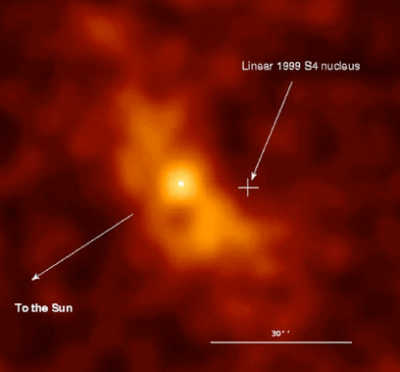
As seen in this X-ray image of
Comet Linear, the X-ray production
occurred at the interface of the
negatively charged cometary
plasma with the positively charged
particles of the solar wind. The
excess of electrons in a cometary
coma was first noted in 1986, when
the Giotto spacecraft detected an
abundance of negatively charged
atoms in the inner coma of Comet
Halley.
Credit:NASA/SAO/CXC/STScI/Lisse et al.
[Click to enlarge]
|
|
|
On July 14, 2000, the Chandra telescope viewed the comet
Linear repeatedly over a 2-hour period, detecting X-rays from
oxygen and nitrogen ions (lower right). The observatory's press
release reports: “The details of the X-ray emission, as recorded
on Chandra's Advanced CCD Imaging Spectrometer, show that
the X-rays are produced by collisions of ions racing away from
the sun (solar wind) with gas in the comet. In the collision the
solar ion captures an electron from a cometary atom into a
high-energy state. The solar ion then kicks out an X-ray as the
electron drops to a lower energy state.”
108
The press release concludes that the Chandra observation
“proves how comets produce X-rays.” Of course it doesn't
prove anything of the sort: in a process of circular reasoning
that has become embarrassingly common in science, the model
provides the interpretation that is then claimed to prove the model. It is
simply assumed that neutral gas from the comet supplies the electrons.
However, that should produce a positively charged shell that would
quickly repel further ions from the Sun. The alternative idea is not
considered: that a comet is negatively charged and via the process of
cathode sputtering supplies copious electrons and negative ions to the
cometary electrical discharge. Negative cometary ions are a puzzle to
astrophysicists because there is no way known of producing them to
match the observed densities.
109
It is now clear that these negative ions
and electrons are jetted into the coma, where they combine with minor
Page 104
ions in the solar wind, giving rise to the observed soft Xrays.
The combination of electrons from the comet with ions
from the solar wind is, of course, an electric discharge—
Nature's efficient means of X-ray production.
The gas 'collision model' is also refuted by the observed Xray
hot spots and rapid variability in intensity. Oscillatory
and 'bursty' behavior is typical of plasma sheaths or double
layers (see [below]).
|
|
|
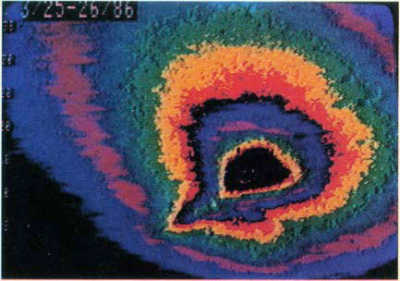
Comet Halley in false color during a
flare up. The jet extends 20,000 km
to the lower left. The Sun is to the
upper right. “The surprises included
sudden outbursts in the presumably
steady vaporization of its icy nucleus
and a periodic, complex pulsation of
the comet's brightness.” Flickers
lasting only a few tens of seconds
were recorded.
Credit: T. Rettig et al.,
See R. A. Kerr, Halley's Confounding
Fireworks, Science, Vol. 234, 5
December 1986, pp. 1196-8.
[Click to enlarge]
|
|
References:
101 www.nasa.gov/vision/universe/solarsystem/stardust-061704.html
102 E. R. Milton, “Glimpses of an Electrical Cosmos,” from a lecture given at
San Jose in August 1980.
103 See APOD website for June 22, 2004.
104 A. Alexander, “Pinnacles, Craters, and Multiple Jets: Early Results
from Stardust Stun Researchers,” The Planetary Society, 17 June 2004.
105 “Comet's Dust Clouds Hit NASA Spacecraft 'Like Thunderbolt,'”
www.sciencedaily.com/releases/2004/06/040618070736.htm
106 H. Alfvén, Cosmic Plasma, Vol. 82, 1981, p. 60.
107 T. T. von Rosenvinge et al., “The International Cometary Explorer
Mission to Comet Giacobini-Zinner,” Science, Vol. 232, 18 April 1986,
p. 355.
108 chandra.harvard.edu/photo/2000/c1999s4/
109 J. Crovisier & T. Encrenaz, Comet Science, “These [negative] ions
occurred with densities 100 times greater than expected, and the
discrepancy with theoretical accounts is still not well understood.””
p. 75.
|
|
|
|
|
Permalink to this article.
Email this article to a friend
Public comment may be made on this article on the
Thunderbolts Forum/Thunderblogs (free membership required).
To read more from Wal Thornhill please visit:
holoscience.com
|
|
|
|
|
|
|
|
|
YouTube video, first glimpses of Episode Two in the "Symbols of an Alien Sky"
series.
|
|
|
|
|
|
|
Three ebooks in the Universe Electric series are
now available. Consistently
praised for easily understandable text and exquisite graphics.
|
|
|
|
|
|
|
|
















